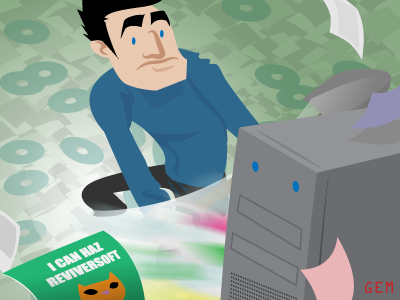-
-
products
-
resources
-
support
-
company
-
All About Hard Drives and Your Data – Tips from Rantz Hoseley
By Steve Horton November 23, 2011guest blog, hard drives, rantz hoseleyNo Comments
Rantz Hoseley
I spent more time on this game than any other: SSX3. I’ve lamented the lack of the SSX franchise on the 360, and I’m actually eagerly awaiting the arrival of the new game like I haven’t for any game in over a decade.
Did I ever want to throw my PC out the window? Frequently. Often. The worst was when we had a presentation for the heads of Sony for approval of the Star Trek game we did for the PSP. We’d spent 38 hours straight getting the new Romulan ship models built, textured and in the game … And suffered a massive power outage that ran longer than our UPSs. I may have cried a little bit.
Rantz Hoseley has been working in the world of telling stories, through comics, prose, and videogames, for over 25 years working on brands such as Star Trek and Disney’s Aladdin. He’s currently forging new territories in the world of digital narratives with his company LongBox, Inc.
I’ve worked in the videogame industry and for many a software development company for 17 years now, and have been working with “high-end” computers in layout and graphics production for 5 years prior to that. This, in a nutshell, makes me the person that friends, in-laws, my kids’ teachers and random people ask about “How to fix their computer.” This plea for help is almost always prefaced with “I don’t know much about computers” or its companion statement, “I’m not interested in playing those Warcrafty games, I just want my system to not be so slow all the time.” I’ve explained many times to them, and now dear reader, to you, that there are some key steps that “gamers” use on running a smooth operating system that will ensure that even the most taxing of Excel spreadsheets will not bog down their system.
Russ Pitts has already covered some important information on keeping your PC “clean,” which can be found here (insert link), and if you haven’t already read them, I would urge you to do so. Go ahead, I’ll be here when you get back.
Now, let’s talk about Hard Drives, your Important Content, and You.
Russ already covered the technical benefits of SSD vs. disc drives, and the importance of making a copy of all your important files and preferences before inserting a new hard drive or reformatting your existing one, but (and I cannot emphasize this enough) having a constant, multi-computer accessible location for your critical files that does NOT reside on your computer’s HD can mean the difference between productivity and letting out a banshee-level wail of agony as you look for the nearest heavy object to smash your computer with. The frequent response to this is, “Well, I only have one computer, so I don’t need to have access to my files using a different machine.” The key to this is understanding, and preparing for the fact that computers (and their related components) break. All. The. Time. That TRS-37 Year-end report you’ve been slaving on for 2 months straight? The one that you’ve been working on the one computer you have? What happens if that computer’s HD fails? Or it becomes corrupted, and you have to reformat (at best) the entire thing? Luckily, there are a number of great (and, more importantly, very affordable options) to keep this from happening to you.
(And yes, I speak from experience here. Painful, sackcloth and ashes grief-type experience. Learn from my pain.)
When I first started working in the Software business, I discovered the “joy” of backups. This was back in 1994, and at the time doing an external backup of your files and content meant having a central server that accessed very expensive software on your computer at a designated time, taking over the machine to copy all of the content, and rendering the computer incapable of doing anything else for the next few hours while the backups occurred. Thankfully, we’ve moved past that. Any PC OS later than Windows XP has a “backup” utility built into it, which allows you to set up an external backup of designated files and directories at a specified time, to an external HD. Things to keep in mind when doing backups:
- Do not back up all of your files. This will not only slow down the backup process, but you will end up with a metric digital ton of “cruft,” temp files, and material that occurs in the normal everyday process of accessing websites, e-mails, and downloading material. Back up only your project/must have folders, as well as your “users” directories (which usually have your preferences, and items such as e-mail files, bookmarks, and attachments contained within it). The subset of this is:
- When using your computer on a daily basis, do not save files and documents to your “My Documents” directory. Not only does this make backing up files and documents more difficult, as you have to go hunting for items amongst the user directories, it also results in a cluttered mix of files and documents you want to have, and files that have come as attachments or temp files that you just looked at, but have no interest in keeping around. My directory structure on all of my PCs is: D:/Docs/Business (or “Writing” or “School”, etc. in the second level.) Yes, it’s “D”, not “C”; we’ll get to the ‘why’ of that momentarily.
By having your files set in criteria-oriented directories, it makes the material not only easier to find when working on it, but also allows you the ability to easily replicate the structure on your external backup. My external backups look identical to my “D” drive, with directories for “Documents”, “Pictures”, “Entertainment”, and the like. This allows me to very easily set up an automatic back up (using the system tools) or to simply drag and drop the entire structure on to an external USB-attached HD.
- There are many options besides using an external HD now available. There’s a lot of chatter and hype about “the cloud” when it comes to computers and mobile devices, and with good reason. Storing material on an external server and being able to access it via your computer, tablet, or smartphone is incredibly handy and can increase your productivity immensely. It’s also a very effective manner to do critical back-ups of important material, ensuring that no matter what happens to your computer, you have ready access to those files and documents. The two current leading services are Dropbox and iCloud. Dropbox has the advantage of working on more devices and computers (you need Windows 7 to use iCloud, and it does not support Android smartphones) and you can selectively ‘share’ access to directories, which is incredibly helpful if you want to hand off a large file to a co-worker or family member that would kill your email program, while still keeping the rest of your files and documents obscured. The big advantage with iCloud is space. If you have multiple gigabytes of material, and you don’t want to pay for storing it, then iCloud is the most cost-effective solution.
 Illustration: Gordon McAlpin
Illustration: Gordon McAlpinComing back to “D”. As mentioned earlier, all of my files, working material, and content is on “D”, not “C”. This is not a secondary HD that I have in my computer. Instead, it is a one terabyte HD that was partitioned into two sections when I did my install of Windows 7 Pro (although you can do the same with Windows XP, Vista, and Windows 7 Home as well, during install). “C” is 200 Gigs, and contains ONLY applications. The “D” partition, the remaining 800 Gigs, contains all of my files, documents and anything I am working on. Now, I know it is very tempting when you get that new 1 terabyte drive to look at it as “One terabyte! That is SO MANY LOLCat pictures I can save!”, but resist. If you want your system to run well, you must remember you do not have 1 terabyte of space.
Those 200 Gigs dedicated to the OS and applications isn’t just to make it easier to back up material I don’t want lost in case of a HW failure. It also ensures that I have “scratch disk” space (open, unallocated memory on disk) to allow the various applications to perform the tasks they need to, writing and deleting temporary data, without ever running up against the limitations imposed by having 100 Gigs of LOLCat pictures on the same partition or drive. Additionally, some applications such as Photoshop prefer to have a “secondary scratch disk” and will complain (as well as operate in a less-than-stellar manner) if you only have one drive or partition. This is because Photoshop (and many graphics and movie applications) need open HD to be able to run free and dance among the flowers. (Or, create the large temporary image files, which can take up multiple gigabytes of space very quickly)
Even with two partitions (or separate HDs), it is critical to the health and operation of your PC to not fill it up to the top. A good general rule of thumb is to a.) keep 25% of your “content” HD or Partition open at all times. And b.) “Defrag” your HD at least every three months using either the system defragmentation utility or a third party application such as Disk Keeper. The best analogy for this is that you can think of your computer as a restless sleeper, who tosses and turns frequently. The “tighter” the sheets the more constricted the sleeper is, and the more tangled up they become. By managing your content, and your HDs, your PC will be much more likely to “get a good night’s sleep.” Which means it won’t keep you up at night.
Was this post helpful?YesNoFree Driver Updates
Update your drivers in less than 2 minutes to enjoy better PC performance - Free.